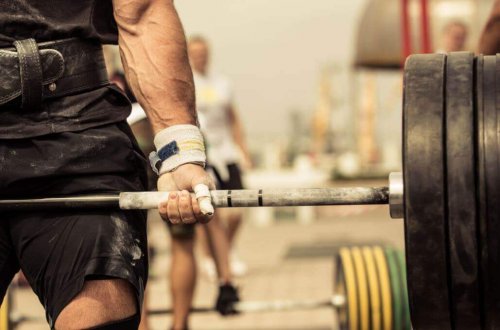The Benefits and Risks of CrossFit: What You Need to Know

CrossFit is a form of high-intensity power fitness that’s become very popular around the world. While its initial goal was to prepare people with physically demanding jobs, nowadays, it’s been adapted to all audiences. Do you know the benefits and risks of CrossFit?
Although this type of training is quite attractive for those who want to lose weight, increase muscle mass, and gain strength, it has some disadvantages people should consider before practicing it. Below, we explain them in detail.
What’s CrossFit?
Before knowing the benefits and risks of CrossFit, it’s important to know what it’s all about.
This is a form of training based on constantly varied exercises with functional movements that are executed at a certain time, which shouldn’t exceed 50 minutes. The activities practiced include cardiovascular exercises, weight lifting, and strength work. It also aims to explore a person’s different skills and physical abilities.
However, it’s necessary to have enough fitness, flexibility, balance, and muscular and respiratory resistance. It also requires proper motion biomechanics, as not doing the exercises properly can lead to spine, joint, and other bodily injuries.
So what are the benefits and risks of CrossFit?

You should also read: Follow An Exercise Routine Without Causing Muscle Hypertrophy
The benefits and risks of CrossFit
Although CrossFit has become popular around the world, its practice is controversial. While many of its benefits have been supported by studies, cases of multiple injuries and serious consequences have led people to believe that it can be dangerous.
The big problem is that many people have decided to practice it without first evaluating their fitness and state of health. Some people have even decided to follow intense workout routines without the supervision of an expert trainer.
Below, we’ll detail these benefits and risks.
The benefits of CrossFit
Contrary to what many people think, CrossFit isn’t an exclusive form of exercise for high-performance athletes. In fact, nowadays, many people practice it around the world.
However, it’s necessary to know how to adapt it to each person’s physical abilities. In this regard, the exercise routine won’t be the same for a person in poor physical condition than for those who exercise regularly or are used to vigorous exercise. Therefore, it’s imperative to consult your doctor and evaluate your physical performance before trying it out.
In light of the above, and respecting the biomechanics of movement of each exercise, CrossFit offers interesting benefits such as:
- It increases cardiovascular and respiratory endurance.
- It increases physical endurance.
- CrossFit enhances coordination and balance.
- It improves mood and self-esteem.
- It helps to increase muscle mass.
- CrossFit helps people lose weight (it’s considered a “fat burner”).
- It fosters relationships, as it’s often practiced in groups.
The risks of CrossFit
As we mentioned above, CrossFit can be dangerous if you don’t take precautions. If you don’t evaluate your current state of health or do vigorous exercises without having the necessary endurance, you can suffer from:
- Muscle, ligament, tendon, and bone injuries.
- Spine injuries.
- Weakening and prolonged fatigue.
- Cardiovascular system changes, such as increased blood pressure.
- Rhabdomyolysis, a condition that involves the breakdown of muscle tissue. As it causes the release of muscle fiber contents in the blood, it can lead to problems such as kidney failure and arrhythmias.

After a physical examination, the doctor can determine the severity and location of the degenerative injury.
Discover: What’s Better When You Exercise: More Weight or More Repetitions?
Tips for practicing CrossFit
To practice CrossFit safely, you need to follow some tips. First of all, it’s essential to determine your state of health and whether you suffer from any conditions. Then, don’t forget that vigorous exercise isn’t recommended in cases of illness.
Apart from this, it’s very important to consult with a trainer specialized in this discipline. The professional can teach you how to do the exercises properly to reduce the risk of injury. Here are other recommendations:
- Start with moderate routines adapted to your physical condition.
- Gradually increase the intensity of the exercises.
- Take enough time to rest and recover.
- Ensure adequate hydration.
- Follow a healthy and balanced diet.
- Warm-up and stretch before doing the exercises.
Are you interested in trying CrossFit out? If so, please remember the benefits and risks and assess whether it’s right for you or not. Also, don’t forget to seek advice before you start.
All cited sources were thoroughly reviewed by our team to ensure their quality, reliability, currency, and validity. The bibliography of this article was considered reliable and of academic or scientific accuracy.
- Adhikari, P., Hari, A., Morel, L., & Bueno, Y. (2021). Exertional Rhabdomyolysis After CrossFit Exercise. Cureus, 13(1), e12630. https://pmc.ncbi.nlm.nih.gov/articles/PMC7872485/
- Alizadeh, S., Daneshjoo, A., Zahiri, A., Anvar, S. H., Goudini, R., Hicks, J. P., Konrad, A., & Behm, D. G. (2023). Resistance Training Induces Improvements in Range of Motion: A Systematic Review and Meta-Analysis. Sports medicine (Auckland, N.Z.), 53(3), 707–722. https://www.ncbi.nlm.nih.gov/pmc/articles/PMC9935664/
- Ángel Rodríguez, M., García-Calleja, P., Terrados, N., Crespo, I., Del Valle, M., & Olmedillas, H. (2022). Injury in CrossFit®: A Systematic Review of Epidemiology and Risk Factors. The Physician and sportsmedicine, 50(1), 3–10. https://pubmed.ncbi.nlm.nih.gov/33322981/
- Arida, R. M., & Teixeira-Machado, L. (2021). The Contribution of Physical Exercise to Brain Resilience. Frontiers in behavioral neuroscience, 14, 626769. https://www.ncbi.nlm.nih.gov/pmc/articles/PMC7874196/
- Boutcher S. H. (2011). High-intensity intermittent exercise and fat loss. Journal of obesity, 2011, 868305. https://www.ncbi.nlm.nih.gov/pmc/articles/PMC2991639/
- Caplin, A., Chen, F. S., Beauchamp, M. R., & Puterman, E. (2021). The effects of exercise intensity on the cortisol response to a subsequent acute psychosocial stressor. Psychoneuroendocrinology, 131(105336), 105336. https://www.sciencedirect.com/science/article/pii/S0306453021002109?via%3Dihub
- Choi, E. J., So, W. Y., & Jeong, T. T. (2017). Effects of the CrossFit Exercise Data Analysis on Body Composition and Blood Profiles. Iranian journal of public health, 46(9), 1292–1294. https://www.ncbi.nlm.nih.gov/pmc/articles/PMC5632332/
- Gianzina, E. A., & Kassotaki, O. A. (2019). The benefits and risks of the high-intensity CrossFit training. Sport Sciences for Health, 15(1), 21–33. https://link.springer.com/article/10.1007/s11332-018-0521-7
- Gilmore, K. E., & Heinrich, K. M. (2016). Crossfit & heart health: Effects of crossfit participation on resting blood pressure and heart rate. Medicine and Science in Sports and Exercise, 48, 293. https://journals.lww.com/acsm-msse/fulltext/2016/05001/crossfit___heart_health__effects_of_crossfit.877.aspx
- Hülsmann, M., Reinecke, K., Barthel, T., & Reinsberger, C. (2021). Musculoskeletal injuries in CrossFit®: A systematic review and meta-analysis of injury rates and locations. Dtsch Z Sportmed, 72(2), 351-358 https://www.germanjournalsportsmedicine.com/archive/archive-2021/issue-7/musculoskeletal-injuries-in-crossfitr-a-systematic-review-and-meta-analysis-of-injury-rates-and-locations/
- Jung, W. S., Hwang, H., Kim, J., Park, H. Y., & Lim, K. (2019). Effect of interval exercise versus continuous exercise on excess post-exercise oxygen consumption during energy-homogenized exercise on a cycle ergometer. Journal of exercise nutrition & biochemistry, 23(2), 45–50. https://www.ncbi.nlm.nih.gov/pmc/articles/PMC6651650/
- Klimek, C., Ashbeck, C., Brook, A. J., & Durall, C. (2018). Are injuries more common with CrossFit training than other forms of exercise? Journal of sport rehabilitation, 27(3), 295–299. https://journals.humankinetics.com/view/journals/jsr/27/3/article-p295.xml
- Meier, N., Sietmann, D., & Schmidt, A. (2023). Comparison of cardiovascular parameters and internal training load of different 1-h training sessions in non-elite CrossFit® athletes. Journal of Science in Sport and Exercise, 5(2), 130–141. https://link.springer.com/article/10.1007/s42978-022-00169-x
- Pavlova, Iuliia & Zastavska, Olena. (2019). INFLUENCE OF CROSSFIT TRAINING ON THE MENTAL CONDITION AND QUALITY OF LIFE OF YOUNG PEOPLE. 1. 62-70. https://www.researchgate.net/publication/338855721_INFLUENCE_OF_CROSSFIT_TRAINING_ON_THE_MENTAL_CONDITION_AND_QUALITY_OF_LIFE_OF_YOUNG_PEOPLE
- Wagener, S., Hoppe, M. W., Hotfiel, T., Engelhardt, M., Javanmardi, S., Baumgart, C., & Freiwald, J. (2020). CrossFit® – Development, Benefits and Risks [CrossFit® – Entwicklung, Nutzen und Risiken]. Sportorthopa¨die-Sporttraumatologie, 36(3), 241–249. https://www.ncbi.nlm.nih.gov/pmc/articles/PMC7473349/
- Whiteman-Sandland, J., Hawkins, J., & Clayton, D. (2018). The role of social capital and community belongingness for exercise adherence: An exploratory study of the CrossFit gym model. Journal of health psychology, 23(12), 1545–1556. https://pubmed.ncbi.nlm.nih.gov/27553606/
- Zhang, Z., Yang, R., Sun, G., & Wang, Y. (2024). Impact of CrossFit Training Programs on the Physical Health and Sociogenic Somatic Anxiety of Adolescents. Iranian journal of public health, 53(7), 1588–1597. https://www.ncbi.nlm.nih.gov/pmc/articles/PMC11287592/
This text is provided for informational purposes only and does not replace consultation with a professional. If in doubt, consult your specialist.








